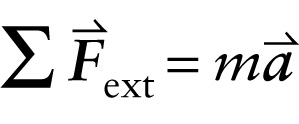Newton’s second law of motion (4-2)
Question
If the net external force on an object is zero...
{"title":"If a net external force acts on an object...","description":"Correct!","type":"correct","color":"#99CCFF","code":"[{\"shape\":\"poly\",\"coords\":\"82,133\"},{\"shape\":\"rect\",\"coords\":\"10,16,12,16\"},{\"shape\":\"poly\",\"coords\":\"144,22\"},{\"shape\":\"rect\",\"coords\":\"66,18,111,84\"}]"} {"title":"...the object accelerates. The acceleration is in the same direction as the net force.","description":"Incorrect","type":"incorrect","color":"#ffff00","code":"[{\"shape\":\"rect\",\"coords\":\"261,29,299,87\"}]"} {"title":"The magnitude of acceleration that the net external force causes depends on the mass m of the object (the quantity of material in the object). The greater the mass, the smaller the acceleration.","description":"Incorrect","type":"incorrect","color":"#00ff00","code":"[{\"shape\":\"rect\",\"coords\":\"208,47,260,85\"}]"}Review
It’s not just Newton’s first law that applies in both frames of reference depicted in Figure 25-3. Newton’s second law also applies in both frames:

As an illustration, suppose the child riding on the train is tossing a ball up and down (Figure 25-5). A passenger seated in the train (frame of reference S′) sees the motion of the ball as purely vertical (We draw the ball's motion with a slight horizontal displacement to distinguish the up and down motion, but this motion is really only along a vertical line). By contrast, a person on the platform (frame of reference S) sees the ball following a parabolic path: The ball has the same horizontal component of velocity Vas the train, and it maintains that horizontal velocity during its flight. As for the child in Figure 25-4, the observers in the two frames of reference disagree about how the ball moves: The motion is along a line as seen in S′)but is in a plane as seen in S. Both observers, however, agree that the ball obeys Newton’s second law. That’s because as observed from both frames of reference, when the ball is in flight only the gravitational force acts on it, and so the acceleration is downward and has magnitude g. In frame S′ the straight up-and-down motion is free fall, as we described in Section 2-7; in frame S the ball is in projectile motion, as we described in Section 3-6. Each description is correct for the frame of reference in which the motion is observed.
